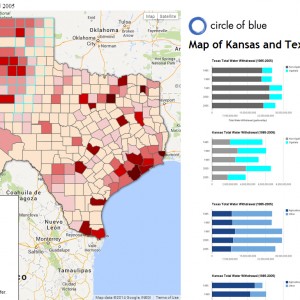Federal Water Tap, June 24: EPA Fracking Studies Delayed and Terminated; President Obama to Speak on Climate Change
Fracking Studies
The U.S. Environmental Protection Agency’s comprehensive study of the effects of hydraulic fracturing on drinking water supplies will be delayed for two years, until 2016. An EPA official made the statement at a shale gas conference in Ohio last week, according to the Associated Press.
The EPA also announced that it would abandon its study of groundwater contamination in a Wyoming town, allegedly from hydraulic fracturing, the natural gas production method also called “fracking.” The EPA released a draft report in December 2011 that indicated fracking had a role in the contamination of Pavillion’s aquifer. The agency delayed the peer review process several times (see below). The state of Wyoming will now be in charge of any further study.
Meanwhile, my quest to learn more about the Pavillion study is closer to the light of day.
I filed a FOIA request with the EPA in January seeking more information about why the agency had announced a third delay of the Pavillion study. After some unreturned emails and a little confusion on the phone, a staffer at the EPA’s Office of Research and Development told me Friday that the documents are ready, needing only one more signature to be released. Stay tuned.
Climate Change Speech
In a speech tomorrow at Georgetown University in the nation’s capital, President Barack Obama will announce his second-term agenda for addressing the causes and effects of climate change. He is expected to recommended carbon-dioxide emissions limits for existing power plants, among a host of other less-controversial items such as energy efficiency.
The White House released a glossy video to promote the speech. Speaking over images of violent storms and receding glaciers, the president says that climate change is a serious challenge “uniquely suited to America’s strengths.”
Then, appealing to the Rust and Corn Belts, Obama says “we’ll need scientists to design new fuels and farmers to grow them. We’ll need engineers to devise new sources of energy and business to make and sell them. We’ll need workers to build the foundation of clean energy economy. And we’ll need all of our citizens to do our part to preserve God’s creation for future generations.”
Colorado River Shortage?
Less than two years from now, the water level in Lake Mead may be within four inches of the first-ever shortage declaration for the Colorado River, according to the latest forecast from the Bureau of Reclamation.
Each month the bureau looks at water conditions two years out. In the June 24-month study, water levels in May 2015 in the nation’s largest reservoir are forecasted to hover just above 1,075 feet, the mark above sea level that would trigger a shortage declaration if breached.
Forecasts, however, can turn around quickly. In 2011, a year after the lake last approached such levels, a wet winter raised water levels by 45 feet. Yet a forecast that takes away that buffer so quickly is a distressing sign.
Asian Carp
If Asian Carp species, currently knocking on the door of the Great Lakes, are to make their home in the largest source of surface freshwater in the U.S., they will need a place to spawn. The U.S. Geological Survey investigated four Great Lakes tributaries, feeding Lakes Michigan and Erie, and found that all four are suitable for spawning.
Moreover, the study found that the number of Great Lakes tributary streams that meet spawning criteria may be higher than the research literature suggests. The stream velocity required to keep eggs adrift is much lower than previously thought, according to the study. If the eggs sink, they perish.
Dead Zone
Drought in the Midwest last year sapped the Mississippi River, resulting in a smaller low-oxygen “dead zone” in the Gulf of Mexico. With heavy spring rains carrying more farm fertilizer, the reverse could be true this year, according to a National Oceanic and Atmospheric Administration forecast. The dead zone could be the largest since measurement began in 1995, if conditions are right when the data are collected starting the end of July. A record-setting dead zone would be roughly the size of New Jersey.
GMO Biofuels
The Department of Energy will conduct a comprehensive review of the potential environmental effects in the southeastern U.S. of field trials conducted under its “engineered high energy crops” program. This program seeks to develop, through biotechnology or hybridization, plants that produce a large amount of energy per acre. Dates for public hearings and comment forms are found on the program’s website.
Federal Water Tap is a weekly digest spotting trends in U.S. government water policy. To get more water news, follow Circle of Blue on Twitter and sign up for our newsletter.
Brett writes about agriculture, energy, infrastructure, and the politics and economics of water in the United States. He also writes the Federal Water Tap, Circle of Blue’s weekly digest of U.S. government water news. He is the winner of two Society of Environmental Journalists reporting awards, one of the top honors in American environmental journalism: first place for explanatory reporting for a series on septic system pollution in the United States(2016) and third place for beat reporting in a small market (2014). He received the Sierra Club’s Distinguished Service Award in 2018. Brett lives in Seattle, where he hikes the mountains and bakes pies. Contact Brett Walton






Leave a Reply
Want to join the discussion?Feel free to contribute!